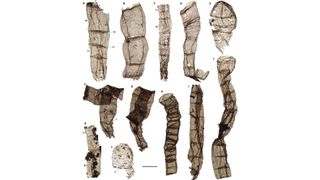1.6-billion-year-old fossils push back origin of multicellular life by tens of millions of years
Researchers uncovered fossils of multicellular eukaryotes that are over a billion years old.

Groundbreaking fossils unearthed in China suggest that multicellular organisms arose earlier than scientists previously thought. The fossils, of what may be an ancient type of photosynthetic alga, are the oldest known multicellular eukaryotes, a group of organisms that contains a clearly defined nucleus full of packaged DNA.
The fossils date back more than 1.6 billion years, which is around 70 million years earlier than scientists previously thought multicellularity arose, according to a new study published Jan. 24 in the journal Science Advances.
The researchers that collected the fossils at China's Chuanlinggou Formation think they represent examples of Qingshania magnifica, which look like filamented tubes made of up to 20 barrel-shaped cells stacked on each other. Some of the samples had spores, which provides evidence that Q. magnifica likely reproduced asexually, the authors wrote in the study.
RELATED: Decades-old question surrounding the start of the tree of life could finally be solved
"These filaments show a certain degree of complexity" based on their variation in appearance, study co-author Lanyun Miao, a scientist at the Chinese Academy of Sciences' Nanjing Institute of Geology and Palaeontology, said in a statement.
The first prokaryotes, or microscopic single-celled organisms without a distinct nucleus, likely emerged by 3.9 billion years ago. But it wasn't until 1.65 billion years ago that the first single-celled eukaryotes, the group that includes all plant and animal life on Earth, showed up in the fossil record in sediments from northern China and northern Australia.
This new study shows that Q. magnifica appeared relatively shortly after that, suggesting that the branch of eukaryotes acquired multicellularity early in its evolutionary history.
Sign up for the Live Science daily newsletter now
Get the world’s most fascinating discoveries delivered straight to your inbox.
"Multicellularity is a prerequisite for any definition of modern complex life, so to reset the timescale on such a foundational event has significant repercussions for how we think about the lineage that would eventually give rise to our own species!" Jack Craig, an assistant professor of research at Temple University who studies evolutionary genomics and was not involved in the study, told Live Science in an email.
This research builds on findings from 1989, when a group of researchers discovered and described the first sample of Q. magnifica in the Chuanlinggou Formation.
"Owing to the poor image quality of the material described and its publication in a relatively difficult-to-access journal, this report has received little attention since its publication," the authors of the new paper wrote.
So they decided to revisit this area in 2015, and uncovered 279 microscopic fossils, all but one of which were Q. magnifica. Further analysis also showed that the organisms had adjoining cell walls, suggesting that they could have obtained energy from photosynthesis, similar to modern-day algae.
The study shows that analyzing ancient organisms can help unravel the evolutionary history of life on Earth, Craig said.
"Positively identifying any fossil over a billion years old is inherently challenging. For example, the oldest dinosaur fossils are only about 250 million years old, and the ones in this study are almost seven times older," he said. "That's why research such as this is exceptionally difficult, but highly rewarding, and when conclusions such as the ones in this study can be reached with high confidence, it represents a significant discovery."

Kiley Price is a former Live Science staff writer based in New York City. Her work has appeared in National Geographic, Slate, Mongabay and more. She holds a bachelor's degree from Wake Forest University, where she studied biology and journalism, and has a master's degree from New York University's Science, Health and Environmental Reporting Program.
Most Popular



